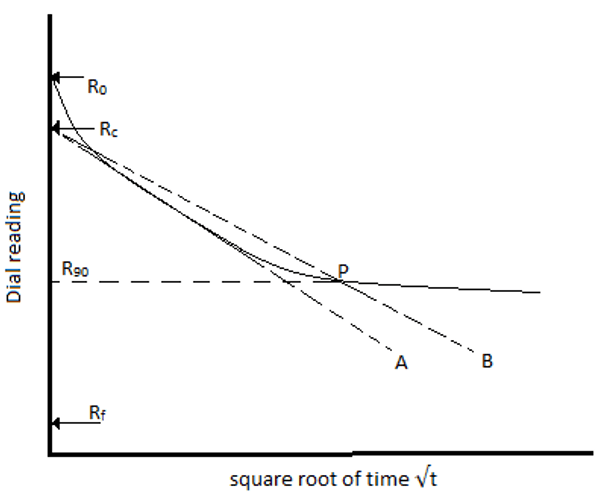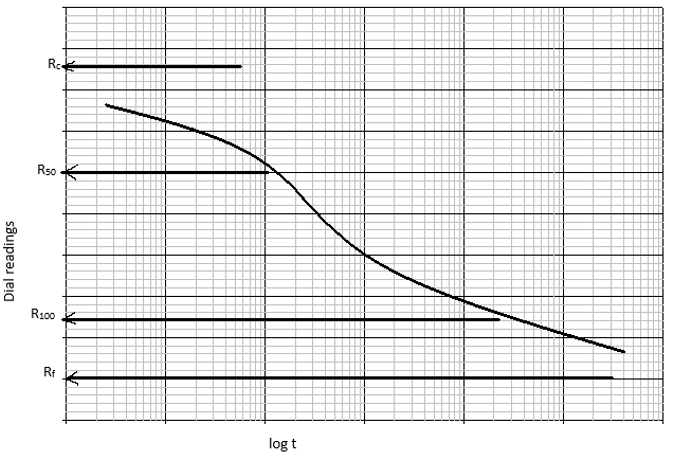This set of Soil Mechanics Assessment Questions and Answers focuses on “Determination of Coefficient of Consolidation – 2”.
1. The graph is plotted with the procedure of square root of time fitting method. The line B is drawn that its abscissa at every point is ______ times that of line A.

a) 1.40
b) 1.30
c) 1.15
d) 0
View Answer
Explanation: When the graph is plotted with the procedure of square root of time fitting method. The line B is drawn that its abscissa at every point is 1.15 times that of line A. The line B is drawn from Rc, instead of the initial reading R0.
2. The average drainage path for the pressure increment is calculated from the formula of ______
a) \(d=\frac{1}{2} \left[\frac{H_{‘}-H_f}{2}\right] \)
b) \(d=\frac{1}{2} \left[\frac{H_{‘}}{2}\right] \)
c) \(d=\frac{1}{2} \left[\frac{H_{‘}-H_f}{4}\right] \)
d) \(d=\frac{1}{2} \left[\frac{H_f-H_{‘}^{’}}{2}\right] \)
View Answer
Explanation: The average drainage path for the pressure increment is calculated from the formula of,
\(d=\frac{1}{2} \left[\frac{H_{‘}-H_f}{2}\right] \)
where, H1=initial height of the specimen under initial load
and Hf=final height of the specimen under final load.
3. The logarithm of time fitting method was suggested by ______
a) Terzaghi
b) Taylor
c) Darcy
d) A.Casagrande
View Answer
Explanation: The logarithm of time fitting method was suggested by A.Casagrande in 1930. The use of square root of fitting method was suggested by Taylor in 1948. Darcy did his research in the permeability of soils.
4. In logarithm of time fitting method, the graph is drawn on a ____________
a) radial graph
b) linear graph
c) semi-log plot
d) log-log plot
View Answer
Explanation: In logarithm of time fitting method, the graph is drawn on a in which the degree of consolidation (U) or the dial readings (R) are plotted in the linear scale and the logarithm of time (log t) in the log scale.
5. The logarithm of time fitting method is based on the characteristic of ______________
a) U and Tv
b) U and log10Tv
c) Tv
d) log10Tv
View Answer
Explanation: The logarithm of time fitting method is based on the characteristic of U and log10Tv in the intersection of the tangent at the point of inflection and the asymptote of the lower portion is at the ordinate of 100% U.
6. The primary consolidation is from _____________

a) R100 to Rf
b) R10 to Rc
c) R1 to Rc
d) Rc to R100
View Answer
Explanation: The consolidation from Rc to R100 is the primary consolidation. The dial reading R100 is given by extending the straight portion of curve to meet the point of 100% consolidation.
7. The secondary consolidation is from __________

a) R10 to Rf
b) R100 to Rf
c) Rc to R100
d) Rf to R100
View Answer
Explanation: The consolidation from R100 to Rf is the secondary consolidation. Usually the secondary consolidation in most of the problems is neglected because of the time it takes to consolidate.
8. For logarithm of time fitting method, the coefficient of consolidation is detained from ________
a) \(c_v=\frac{(T_v)_{70} d^3}{t_{70}} \)
b) \(c_v=\frac{(T_v)_{80} d^2}{t_{80}} \)
c) \(c_v=\frac{(T_v)_{90} d^4}{t_{90}} \)
d) \(c_v=\frac{(T_v)_{50} d^2}{t_{50}} \)
View Answer
Explanation: For logarithm of time fitting method, the coefficient of consolidation is detained from,
\(c_v=\frac{(T_v)_{50} d^2}{t_{50}}\)
where, cv=coefficient of consolidation
(Tv)50=time factor corresponding to 50% consolidation
t50=elapsed time for 50% consolidation
d=average drainage path for pressure increment.
9. From the coefficient of consolidation and coefficient of volume change, the coefficient of permeability is found by equation ____________
a) k=mv γv
b) k=Cv γv
c) k=Cv mv γv
d) k=Cv mv
View Answer
Explanation: The coefficient of consolidation is given by the formula,
\(C_v=\frac{k}{m_vγ_v}\). Therefore, on rearranging the equation,
∴ k=Cv mv γv.
10. From the coefficient of consolidation and coefficient of compressibility, the coefficient of permeability is found by equation __________
a) \(k=\frac{γ_w}{1+e_o} \)
b) \(k=\frac{C_v a_v Aγ_w}{1+e_o} \)
c) \(k=\frac{a_v γ_w}{1+e_o} \)
d) \(k=\frac{C_v a_v γ_w}{1+e_o} \)
View Answer
Explanation: Since the coefficient of permeability is given by the equation,
k=Cv mv γw —————–(1)
The coefficient of volume change is given by,
\(m_v=\frac{a_v}{1+e_0},\) therefore substituting in (1),
\(k=\frac{C_v a_v γ_w}{1+e_o} \).
Sanfoundry Global Education & Learning Series – Soil Mechanics.
To practice all areas of Soil Mechanics Assessment Questions, here is complete set of 1000+ Multiple Choice Questions and Answers.
If you find a mistake in question / option / answer, kindly take a screenshot and email to [email protected]
- Check Geotechnical Engineering I Books
- Practice Civil Engineering MCQs
- Practice Geotechnical Engineering II MCQs
- Check Civil Engineering Books
- Apply for Civil Engineering Internship
